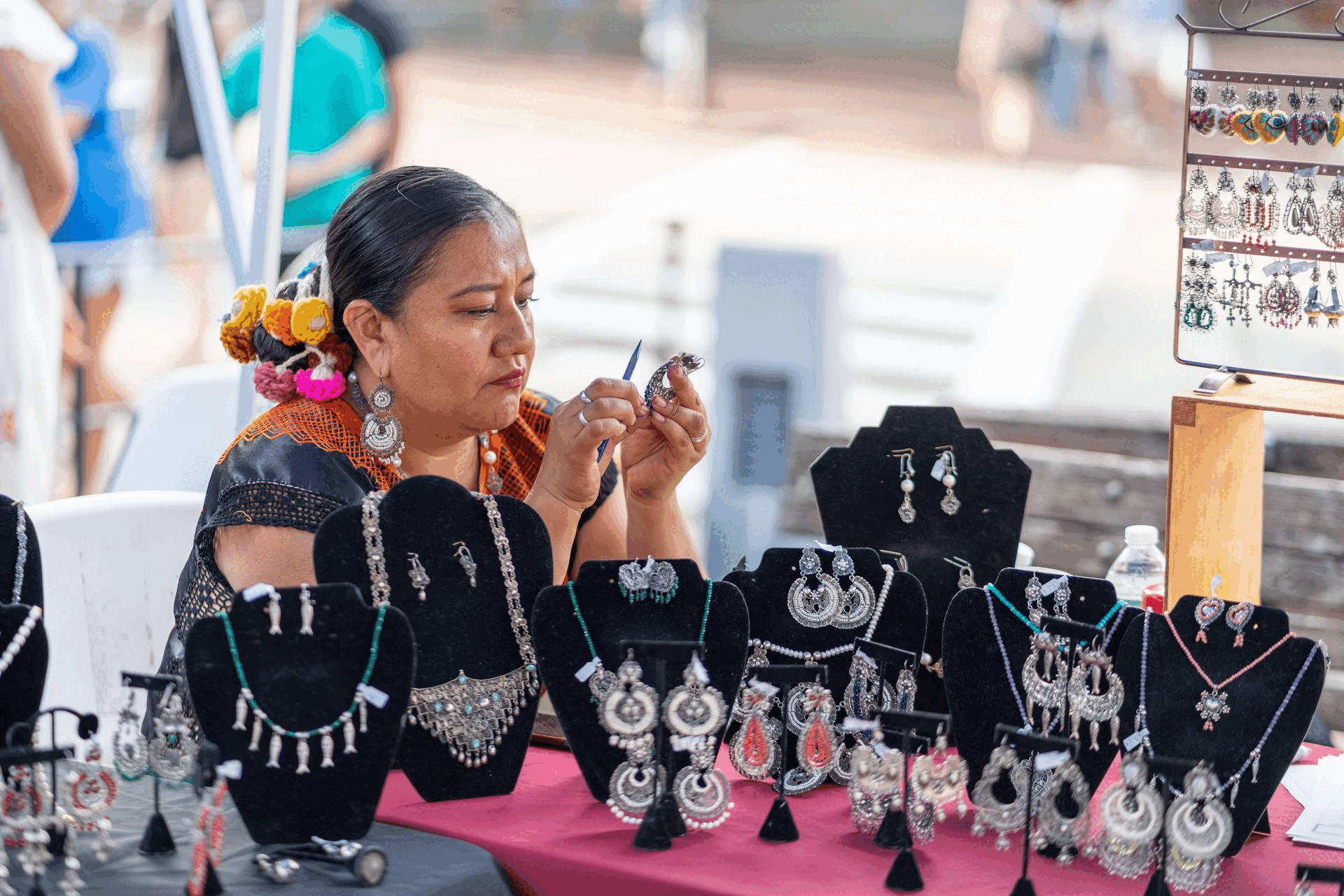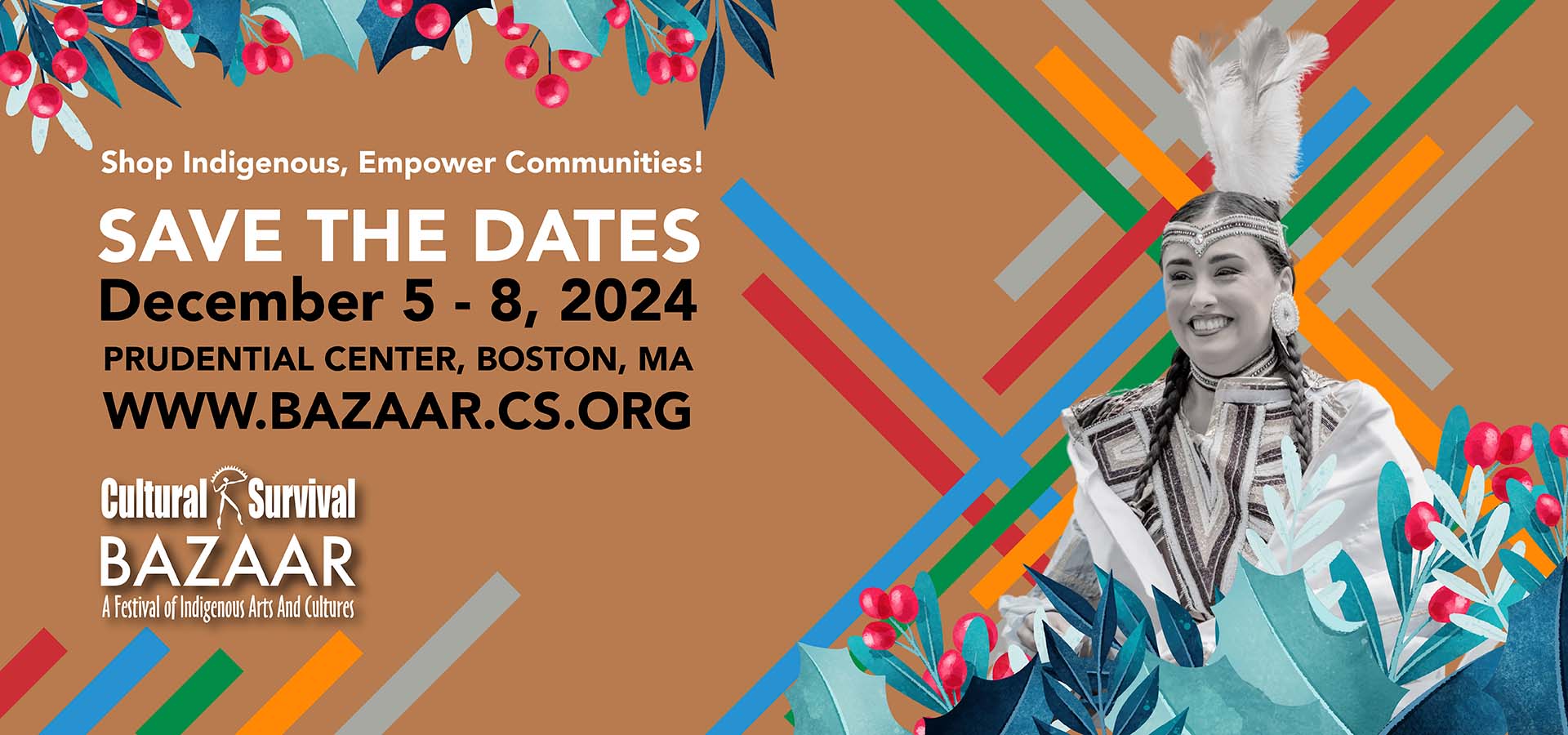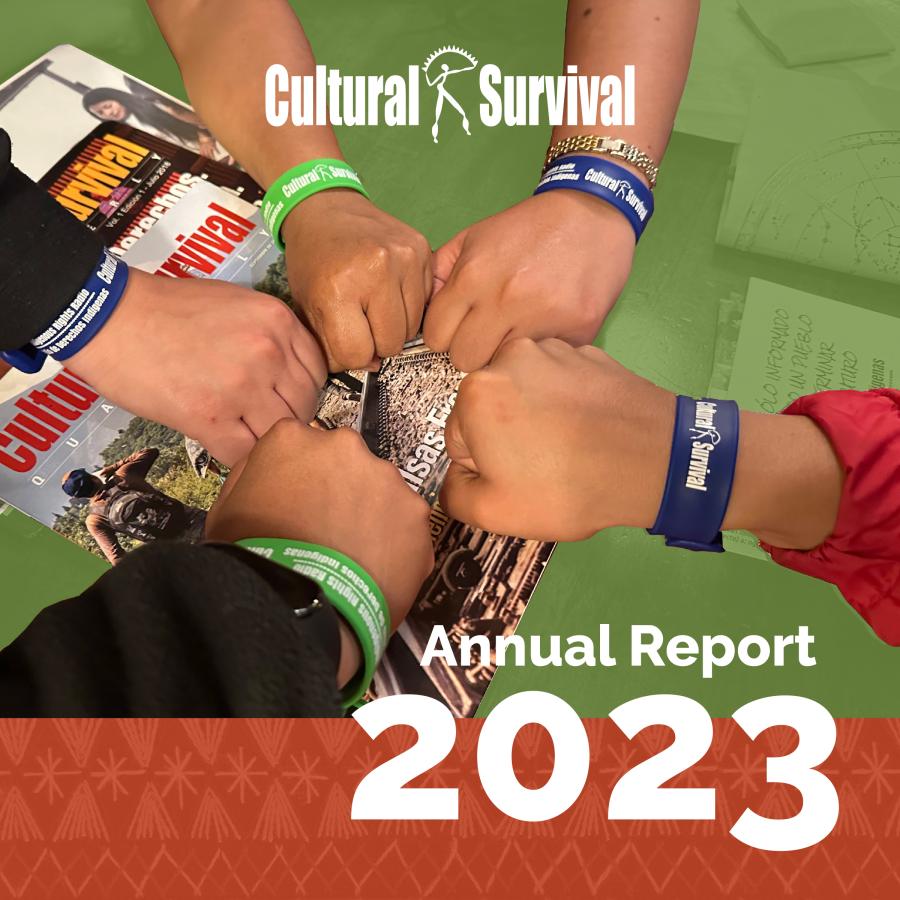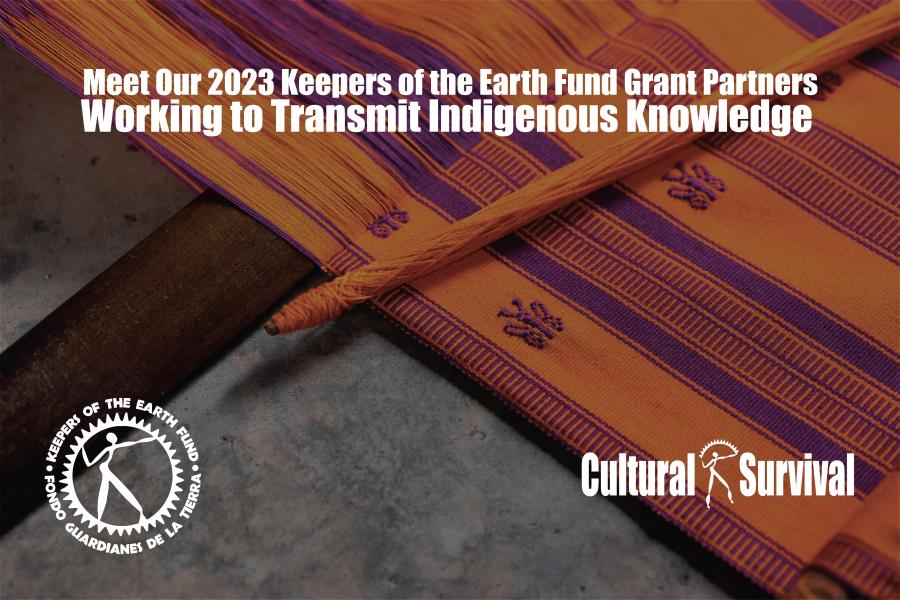
By Candyce Testa (Pequot), Maya Lazzaro (Quechua), Kelsey Armeni, Pablo Xol (Maya Qʼeqchiʼ)
The Cultural Survival Bazaars are a mainstay of the impactful, Indigenous-led, non-governmental organization Cultural Survival, and were co-founded 49 years ago by Pia and David Mayberry Lewis. After a three-year hiatus due to the pandemic, the Cultural Survival Winter Bazaar returned to the Prudential Center in Boston last December, and the first post-COVID Summer Bazaars were held in July 2024 in Newburyport, MA, and Tiverton, RI.
Artisans and artists have survived centuries of colonization by maintaining their cultures and traditional ways of producing and creating. Cultural Survival Bazaars have created a platform for Indigenous Peoples worldwide to showcase and sell their hand-made, one-of-a-kind art in highly populated venues with wrap-around vendor support and networking opportunities in North America.
Our goal to support Indigenous artisans and artists is rooted in Article 20 of the United Nations Declaration of Indigenous Peoples, which states that “Indigenous Peoples have a right to maintain their economic systems, to be secure in the enjoyment of their means of subsistence, and to engage freely in traditional and economic activities.”
The Bazaars provide more than shopping opportunities. They cultivate an awareness of Indigenous Peoples, their visions, voices, and needs among audiences who want to learn more and take action to become much-needed allies. These allies become volunteers, sponsors, hosts, and cherished members of our Cultural Survival family.
Indigenous women and children directly benefit when a sustainable income is generated without leaving their homelands—or even their homes. Women can live within the cultural norms of their communities, caring for both their homes and families and creating items of value. The sales of these items provide them with the economic freedom to have the socio-economic power required to make important daily life decisions.
These handmade products are forms of self-expression that have emerged from the worldviews of Indigenous communities; worldviews that are the result of living within contemporary Indigenous cultures that are ever-growing, ever-shifting, and ever-evolving to meet the needs of their people.
Cultural Survival Bazaar participants can experience the merging of past, present, and future when holding a basket woven of recycled telephone wires constructed using ancestral techniques and patterns. These baskets have given women, children, and whole communities hope for a future of their own making.
We are thrilled that by vending at three Bazaars, 43 vendors raised close to a half million dollars within one year, impacting the lives of over 4,000 Indigenous people belonging to the following communities:
- Mam, Maya Kaqchikel, Maya Tz’utujiil, Maya Achi, and Maya K’iche’ Peoples in Guatemala
- Nahua, Nahuatl, Mixteco, Wixarika o Huicho, and Zapoteco Peoples in Mexico
- Haitian People in Haiti
- Zulu, Bayei, and Hambukushu Peoples in South Africa
- Anatolian Peoples in Southern Turkey
- Buganda and Acholi Peoples in Uganda
- Kisii, Akamba, Kikuyu, Maasai, Samburu, and Luhya Peoples in Kenya
- Palestinians from the West Bank
- Kashmir, Phulkar, and Punjab Peoples in India
- Bhotiya and Kumaoni Tribes from the Himalayas
- Shona Peoples in Zimbabwe
- Uzbek and Bukhara Peoples in Uzbekistan
- Lao, Katu, Akha, Phu Thai, Tai Lue, Lantern, Yao Mien, and Hmong Peoples in Thailand
- Aymara, Ayacuchano, and Quechua Peoples in Peru
- Hutsul Peoples in Ukraine
- Berber Peoples in Algeria
- Macedonian Peoples in Macedonia
- Kami, Newar, Tamang, Magar, Tharu, and Yadav Peoples in Nepal
- Aquinnah Wampanoag and Dine’/Navajo Peoples in the USA
- Nasa and Pueblo Wayuu Peoples in Colombia
- Mapuche Peoples in Chile
From the Vendors and Artists:
The Bazaars create an opportunity for Indigenous artists and artisans and entire communities to thrive while sharing their culture with the world. Cultural Survival Bazaars are a space for these artists to "be fully themselves" while promoting their art. The return of the Cultural Survival Bazaars offers renewed hope for artisans to expand the reach of their work, connect with old friends, and create community with other Indigenous Peoples from around the world.
"There is a hope we can see," Akhtar Mir of Afra Kashmir said when asked what benefit the Bazaars provide for him and his community. The idea of “a hope we can see” is reflected in the stories of our vendors and the reason that over 84 percent of vendors return every year. The Cultural Survival Bazaars offer a market for artisans to sell their products, which has a ripple effect on Indigenous women, youth, cultural resilience, and livelihoods around the world. Ganna Nepyivoda, whose craft reflects the culture of Hutsuls in Ukraine, notes that the business from the Bazaars "allows the women to support themselves and their work without leaving their community, promoting economic autonomy and keeping communities together.” Julio Laja Chichicaxtle from Papel Amate, a vendor who has been coming to the Bazaars for many years, has observed that when business flourishes, artisans can offer more work to people in their community back home. Roberto Cachimuel from Yarina Threads in Ecuador recognizes that the business the Bazaar brings helps artisans "sustain their families and send their kids to school. [The parents] can make time for themselves without having to worry about money. They can send their kids to extracurricular activities.”

Meet the Vendors and Artists:
A Thread of Hope - A Thread of Hope Guatemalan Fair Trade has worked with Indigenous Maya artisan co-ops, groups, and families for 20 years, serving over 450 local Mayan artisans. A Thread of Hope offers high-quality, beautiful, and useful crafts, including handwoven and hand-dyed lightweight bamboo and bamboo chenille accessories, jewelry, home goods, and more.
Afra Kashmir - Ahktar Mir is an artisan from Kashmir Valley, situated in northern India. Located mostly in the Himalayan Mountains, Kashmir Valley is famous for its beautiful mountainous landscape, lakes, rivers, and gardens. He belongs to Kashmir and Kashmir art is in his blood. Historically, Kashmir became known worldwide when its cashmere shawls were exported to other regions and nations.
Afri-Root Collective - Due to the high level of poverty in Uganda, Kenya, and Tanzania, most people, especially women, struggle to fulfill their obligations as caretakers of their families. Along with agriculture, craft-making is a major activity that promotes community growth. The Afri-Root Collective is a socially responsible business that sells exquisite artwork from various talented and highly skilled artisans in East Africa. Profits benefit the artisans, and a portion of each sale is reinvested in training others, especially women, to learn skills and work toward sustainability.
Antiguas Maravillas - Donaji of Antiguas Maravillas and her family create a wide variety of artwork and jewelry including necklaces, earrings, rings, bracelets, religious art, belts, combs, ancient models, and figures with dazzling details of Donaji’s metal artwork using the delicate filigree method of making metal jewelry. The traditional filigree method that Donaji learned typically involves using gold and silver to make tiny beads, twisted threads, or both. Donaji describes her family’s artwork as full of tradition and history, and her pieces are used in religious ceremonies throughout the area.
Arte Plumario Kozamalotl - Rubén Flores Apaez, a Nahua artist from Guerrero, Mexico, has devoted 25 years to the ancient art of feather work, inspired by his deep admiration for birds. For over 18 years, he has collaborated with Gastón Aguilar as part of Arte Plumario Kozamalotl, focusing on bird representations. Sourcing feathers sustainably from certified aviaries and their own raised birds, Flores’ art preserves a valued cultural tradition while also providing income for his family. Flores takes pride in promoting this delicate art, which helps others appreciate the cultural significance of feathers in Indigenous history.
Arte Wixarika - Herminio Ramirez is a Wixarika artisan from the Jalisco desert region of Mexico. Arte Wixarika’s art includes yarn paintings, beaded sculptures, and beaded necklaces, bracelets, and earrings created by Herminio and other members of his family and community. Each piece is an inspiration and vision gifted from the peyote cactus medicinal plant to the artisan. Symbolism and visions are portrayed in each piece and include depictions of creation stories and different animal characters such as the blue deer, the eagle, the scorpio, and the spider.
Berber Art - Hocine Bazine is a Berber weaver who helps many families rise out of poverty by buying their wool and employing them as weavers through Berber Art. Berber Art is based in the heart of Algeria, part of the home of the Indigenous Amazigh/Berber Tribe, the Beni M'zab. Traditional techniques and designs are passed on from one generation to the next. Rug weaving has long been a major family craft in the region and is the main source of income for many families.
Crafts Without Borders - Crafts Without Borders sells handmade jewelry, clothing, purses, and décor by skilled artisans from around the world. They are passionate about promoting unique and beautiful crafts while providing a sustainable wage for families in other countries.
Dialekto - Marco is a Mixtec artisan from Oaxaca, Mexico. He is a muralist, jewelry designer, and painter. He emphasizes the usage of recycled materials such as found shells and vintage beads for his jewelry pieces and cardboard from fruit and pizza boxes for his murals and canvases.
Domingo Shona Wire Art: A Legacy of Creativity and Resilience - Growing up in Zimbabwe where toys were often a luxury, young boys like Domingo and his peers in the Shona Tribe turned to their resourcefulness and creativity to craft their playthings. In the 1960s, an artisan tradition began with a simple material: wire coat hangers. From these humble beginnings, wire sculpting emerged, with young artists fashioning intricate motor cars and other toys. Over time, this craft became deeply connected with the Shona Tribe, the largest cultural group in Zimbabwe, who are now renowned for their sculptural artistry.
Eve and Nico Gifts - Eve and Nico Gifts & Home Décor is a Black-owned, woman-founded company that has been in business for over 12 years. Its roots are ingrained in African history and its future, specifically in South Africa and other countries in Southern and Eastern Africa. Eve and Nico Gifts and Home Décor encourages the ongoing development of Indigenous women's empowerment by creating diverse markets for its goods.
Everest Wings - Vikrant Rana is originally from Nepal. His company, Everest Wings, sells handcrafted products made by Kami, Newar, Tamang, Magar, Tharu, and Yadav Peoples, who range from the Himalayas to the lowlands of Nepal. The business was born out of tragedy; in the wake of the 2015 earthquake that devastated his homeland, Rana was moved to help rebuild back home, so he started selling hemp products like backpacks and hats. “We felt like we were not only selling the product, but we were telling people about how beautiful our culture is,” Rana says.
Felicia Huarsaya - Aymara weaver Felicia Huarsaya Villasante comes from a small community in the Peruvian province of Azangaro, almost 16,000 feet above sea level, near Lake Titicaca. The female farmers in the area sell weavings as part of a collective. They use only high-quality alpaca fibers and sheep’s wool to create sweaters, scarves, hats, mittens, and finger puppets. In addition to her work as an Indigenous artisan, Huarsaya has also been involved with the United Nations Permanent Forum on Indigenous Issues including climate change.
Fine Kenyan Crafts - Tory Khakali sells handmade crafts and accessories from artisans in Kenya. Her goal is to buy directly from the artists to enhance their livelihood by excluding the middlemen. Though not officially Fair Trade certified, she commits to directly impacting and supporting artists and has been in business for more than 15 years. She grew up in the business, with her father having owned a store and been a collector of Indigenous artwork and unique authentic artifacts from East, West, and North Africa for over 30 years. Since his passing, she continues his legacy of buying crafts and jewelry directly from individual artists.
Ganna Nepyivoda - Ganna Nepyivoda’s crafts represent the culture of the Hutsuls, an ethno-cultural group of Ukrainian highlanders. Nepyivoda started learning traditional embroidery and carpet weaving at a young age from her mother. She later earned degrees from the Folk Arts College in Kosiv and the Institute of Applied Arts in Lviv. There, she obtained her skills in the craft of leatherwork and pysanka (painted eggs), and has since managed to revive the almost-disappeared pysanka designs of her local community. “To refine the delicacy and fascination of original folk art is my spiritual commitment,” she says.
GuateMaya Art and Culture Connection - The GuateMaya Art and Culture Connection features original art and crafts from traditional Maya villages around Lake Atitlan in Guatemala. The paintings depict scenes such as harvesting coffee, markets, food, ceremonies, and nature that are an integral part of life and culture. The artists are known for their distinctive style and their works have been exhibited in places such as the Smithsonian and galleries and shows internationally.
Hebron Glass - Beautiful, colorful swirls of sea glass describe the art of Hebron Glass, a family-owned traditional Palestinian glass-blowing business. “According to family history, this craft correlates with the Natsheh family’s presence in Hebron between 122 BCE–330 CE,” says artist and co-owner Hamzeh Natsheh. Established in 1890 and located in the city of Hebron in the West Bank, Hebron Glass employs approximately 60 artisans who work in one of three workshops across the city or from their homes. Hebron Glass aims to partner with Fair Trade associations and uses recycled bottles from local homes and businesses as the raw base material in many of their products. The fuel for the ovens and furnaces is repurposed motor oil from local garages. Natsheh says the Israeli-Palestinian conflict and constraints on freedom of movement in Palestine have impacted the industry, but by recycling these everyday materials, Hebron Glass is able to keep the craft alive and sustainable.
Himalayan Naari - For centuries, women in the Himalayas have been making woolen clothing to cope with the cold, mountainous climate of their homes. The artisans of Naari, having been raised in this wool-working tradition, learned knitting and weaving from their mothers. Today they work with professional designers, joining their traditional patterns and stitches with contemporary concepts to create fashionable products.
Katarina Doda - Katarina Doda, a silversmith from North Macedonia, specializes in filigree art jewelry, a tradition passed down through her family for generations. Using silver and occasionally semi-precious stones, she meticulously crafts each piece by hand, starting from melting the silver to shaping intricate designs. For Doda, this craft is not just a profession but a lifelong connection to her family's heritage and tradition.
Konbit Sante - Konbit Sante Cap-Haitien Health Partnership is a nonprofit corporation founded in Maine. Konbit is a traditional form of communal labor in Haiti in which the people help each other prepare their fields for planting, and sante is Creole for health. Through the sales of traditional local Haitian arts and crafts, Konbit Sante is able to help fund their organization, which is dedicated to supporting medical and social needs within Haiti.
Mayamam Weavers - Located in the western highlands of Guatemala, Mayamam Weavers is a vibrant women's weaving cooperative focused on preserving traditional weaving techniques. The cooperative offers a captivating array of handwoven products ranging from tapestries to thoughtfully crafted home goods, stylish clothing, and accessories.
Nodirjon Kattaev - Nodir Kattaev is an artisan from the city of Bukhara, Uzbekistan, who specializes in miniature paintings. His traditional silk hand embroidery incorporates natural dyes from a local plantation and the technology of Ikat embroidery, a characteristic of the Lakaya ethnic group residing in the territory.
Ockway Bay Wampum - Ockway Bay Wampum specializes in contemporary wampum jewelry handcrafted and designed by Mashpee Wampanoag artist and Cultural Survival writer-in-residence Hartman Deetz. Wampum are beads and jewelry cut from Quahog clam shells. These wampum beads were the main material used in wampum belts, which once served as treaties between Tribal Nations and the U.S government.
Painted Arrow Studio - Deborah Spears Moorehead is a conceptual fine artist, illustrator, muralist, traditional cultural bearer, storyteller, author, songwriter, and performer belonging to the Seaconke Pokanoket Wampanoag Tribal Nation of Massachusetts and Rhode Island. She has a Master of Arts in Cultural Sustainability from Goucher College and a Bachelor of Fine Arts from Swain School of Design, and her art focuses on the contemporary cultural existence of Eastern Woodland Native American communities and their sustainability. She owns Painted Arrow Studio and Talking Water Productions, where she teaches, creates art, and produces various cultural products. She has received numerous awards and has collaborated on various projects, including public murals and book illustrations. Of her art, she says, “My work aims to educate, dispel negative stereotypes, and promote awareness of social and economic inequities faced by Native Americans.”
Papel Amate Otomí de Mexico - In San Pablito, Puebla, México, there is a tradition of making papel amate (Otomi bark paper). The paper's origin is the Popova tree, celebrated in the Ñühü language as a "generous tree" for its ability to yield four distinct hues without harm during year-round harvesting. Each piece takes days to create, from bark collection by the community to the meticulous crafting process. As the fresh bark dries, the dry bark undergoes a transformative cooking ritual with lime, ash, and firewood, resulting in rich brown, pure white, vibrant green, and earthy ochre colors. From table settings to wall hangings, these papel amate creations transcend mere art; they become cherished stories woven into the fabric of homes.
Philbert Begay - Philbert Begay (Diné/Navajo) learned the century-old art of Navajo silversmithing from his father, Richard Begay, who learned from his grandfathers. Over time and through many experiences, Begay emulated his father and evolved to become meticulous at creating hand-cut, overlaid, hand-stamped, and inlaid designs. “The symbols and creations are based on animals and places. The wind, the rain, the skies, the stars...something that is harmonious and together in the world. Everything is connected; that is how it is and how we live,” he says.
Premla - In 1976, at the age of 16, Pralhad KC immigrated from Kathmandu, Nepal to Boston. He has served as an International Consultant for the United Nations Development Project, where he has helped to manage a Nepalese women’s cooperative that strives to help train women with marketable skills and provides the women with a fair price outlet for their goods. Committed to the concept of Fair Trade, Pralhad endeavors to buy and sell the crafts produced by the people of Nepal according to the highest ethical standards. Every item sold through his store has been acquired to improve the quality of life for whomever produced it.
Project Have Hope - Project Have Hope is a nonprofit organization dedicated to promoting educational and business initiatives for Ugandan artists and their families. The organization strives to empower women in the Acholi Quarter of Uganda by offering them educational opportunities and fostering sustainable businesses to stimulate economic development. These include providing scholastic sponsorship to artisans’ children, offering vocational training to enhance employment prospects, extending small business loans and grants to women, implementing a breakfast program, and conducting community outreach initiatives to provide assistance where needed.
Radical Grandma Collective - The Radical Grandma Collective is an international and intergenerational solidarity effort supporting environmental justice activists in northeast Thailand. Their story began in Na Nong Bong, where weaving has funded the fight for reparations in the wake of a devastating legacy of gold mining. Today, their impact expands beyond borders to support other Thai human rights defenders and connect students with environmental justice movements.
Ravinder Kumar - Ravinder Kumar is a renowned artist of the traditional art of phulkari, a type of embroidery that means “flower work,” which he learned from his great-grandmother. He runs multi-generational training sessions to keep the art alive, with children from all over India seeking to enroll in these sessions. He has been invited to the American Embassy School to demonstrate phulkari and has showcased his craft in Chile, Ecuador, the United States, Germany, Brazil, Oman, Peru, and Canada, in addition to many exhibitions within India. His work includes a wide range of phulkari in different materials with different designs such as floral motifs, geometric shapes, and other patterns.
Retablos Palomino & Jimenez - Retablos Palomino & Jimenez rescue and safeguard the traditional Peruvian folk art of Retablos. Zuly Palomino Jimenez is the daughter of Ayacuchana, an altarpiece master, and is the fourth generation of her family to continue the artisan tradition of using potato dough and plaster to make beautiful sculptures. Thanks to the art and their work, they are able to preserve knowledge that has been handed down from generation to generation. Palomino preserves the tradition of making retablos, frames, ornaments, and paintings using traditional techniques and recycling items to decorate her works.
Samadjon Ikramov - Samadjon Ikramov is part of the seventh generation of a family of blacksmiths in the city of Bukhara, Uzbekistan, who practices special knife-making arts. His work has been exhibited all over the world, including the United States, England, Germany, Spain, Italy, Singapore, India, and Pakistan.
Sanjar Nazarov - Sanjar Nazarov is a third-generation master embroiderer who has received various awards for his work, including the UNESCO Award of Excellence. Nazarov works with a team of family members, apprentices, and other textile workers and has a large workshop outside of Bukhara, Uzbekistan where he creates an array of richly woven and embroidered products including colorful boots, coats, and home textiles. Most of the designs are traditional to the nomadic Lakai people of Uzbekistan.
Serzhan Bashirov - Serzhan Bashirov renowned for his exquisite silver craftsmanship, Serzhan Bashirov has captivated the world with his unique designs that seamlessly blend tradition and innovation from his home country of Kazakhstan. As a three-time UNESCO award-winning jewelry designer, Bashirov’s creations are both visually stunning and deeply rooted in cultural heritage and artisanal mastery.
Taleo Handmade - Taleo Handmade works with women in remote Southeast Asian villages who use naturally dyed hemp and cotton textiles and other traditional techniques to create handwoven textiles. They embrace Fair Trade principles and promote sustainable livelihoods for skilled traditional weavers, natural dyers, batik artists, and embroiderers. Taleo Handmade creates one-of-a-kind bags, accessories, and homewares and uses zero-waste designs to give new life to traditional vintage textiles.
Tanzania School Foundation - The Tanzania School Foundation has worked since 2011 to provide quality free education to disadvantaged children in Tanzania. They partner with 100 artisans in Tanzania to sell home décor, apparel, and accessories designed and made locally combining traditional techniques, local materials, and amazing artisan skill. They work to help integrate artisans in Tanzania into the global economy by bringing their products to the international market and providing them with fair, consistent income for their work.
Tigris Handmade - Tigris Handmade designs and creates handmade leather shoes using a shoe-making technique passed down from generation to generation for more than 600 years in Anatolia, Turkey. The shoes are made from all-natural and ethically sourced leather, beeswax-coated cotton twine, plant-based glue, and dyes, staying true to tradition throughout the entire process. The final product is a simple and beautiful shoe that is extremely comfortable.
Timoteo Ccarita Sacaca - Timoteo Ccarita Sacaca is a Quechua master weaver, natural dyes researcher, and weaving teacher from Pitumarca, Cusco, Peru. He uses natural dyes and alpaca wool in a continuation of traditional practices that have spanned generations. He hand-spins alpaca fiber to create yarn, then weaves using handlooms. His traditional designs are inspired by Incan messages, symbols, and ideas. The traditional weavings in Pitumarca have maintained original designs and symbolism for thousands of years. Symbols are profound mysteries embodied ethnographically in each ancestral textile. He is one of a few known weavers who kept the ancient art of tapestry from the Inca nobles.
Two Souls - Kleidy started Two Souls started as a way to bring the beautiful craftsmanship of the Indigenous Maya women of Guatemala to America. Kleidy was always in awe as a child of the incredible work in the villages made by hand by the local women. All of the pieces are handmade and Fair Trade products. The colors, fabrics, and designs are inspired by Mayan culture, symbolism, and connection to nature. Two Souls is committed to supporting the economy and lifestyles of the local families in Guatemala.
US Sherpa - Ongyel Sherpa is the founder and CEO of US Sherpa. Born and raised in Nepal as a Sherpa, his entire family worked in the trekking and mountaineering profession. The mountaineering connection led him to get a once-in-a-lifetime opportunity to come to the United States, and years later, in 2006, he founded US Sherpa. The company produces functional, natural fiber products handcrafted in Nepal for the active outdoor lifestyle, directly creating jobs and income for the Nepalese communities. Though he now resides in Vermont, Sherpa returns to Nepal every year to source products and guide trips.
Wayakana “Nosotras” - The Wayuu women of Colombia and Venezuela seek to dignify their work as textile artists and give fair value to their ancient memory. All of their art is handmade using traditional forms. They sell baskets, handbags, hats, and jewelry to support families in their communities.
Yarina - Roberto Cachimuel is one of the founding members of Yarina, a family of musicians from Otavalo, Ecuador that has received wide acclaim in their home country and abroad. Yarina, meaning ‘remembrance’ in Cachimuel’s native language, Quechua, was formed in 1984 to promote Native arts and culture during the formative years of Ecuador’s burgeoning Indigenous political and cultural rights movement.
Yolopopotli - Roberto Mejía Muñoz and Patricia García are two passionate Nahuatl artists from Mexico who have woven a vibrant legacy in craftsmanship for two decades. Their crafts, deeply rooted in Nahuatl heritage, exhibit the use of popotillo, a straw-like grass from the Valle de Mexico. Using natural dyes and eco-friendly glue, their family imparts three generations' worth of skills to the community. Representing Yolopopotli at Cultural Survival Bazaars, they united four families, each infusing their creations with personal experiences and visions. In their hands, popotillo crafts become a celebration of diverse perspectives on life and the world.
Zienzele Foundation - The Zienzele Foundation works in some of the poorest villages in Zimbabwe. Through traditional Zimbabwean basket-weaving and other projects, their women's cooperatives earn money to help support themselves and care for over 1,000 orphans. All of the proceeds go towards school fees for HIV orphans.




